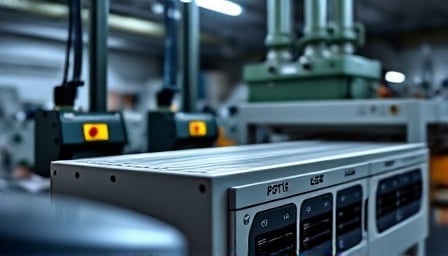Corporate Analysis: Corning Incorporated Amid Shifting Macro‑Signals
Corning Incorporated (NASDAQ: CLR) remains a bellwether for the convergence of optics, telecommunications, and consumer electronics. Its core business—manufacturing optical fiber, cable, and photonic components—anchors the high‑speed data networks that underpin the Internet of Things, 5G rollouts, and cloud infrastructure. Recent investor sentiment, coupled with macro‑economic uncertainty, creates a paradoxical landscape: optimism about Corning’s technical trajectory clashes with caution about the broader market’s resilience.
1. Investor Sentiment and Market Position
The company’s share price has held steady at roughly US $78, reflecting a balance between growth expectations and risk premiums. With a market capitalization near US $59.7 billion, Corning occupies a sizable niche in the global high‑performance optics market. Analysts note that its revenue mix—approximately 45 % from telecom, 25 % from consumer electronics (notably Apple), and the remaining from data centers and industrial applications—provides a diversified moat against sector‑specific downturns.
Jim Cramer’s recurring endorsement on CNBC underscores a bullish narrative: Corning’s product pipeline, including its latest “C‑Fiber” line for 400 Gbps data transmission, aligns with the relentless demand for higher bandwidth. However, Cramer’s perspective is often framed in terms of short‑term price momentum rather than a rigorous assessment of supply‑chain dynamics or geopolitical risks.
2. Technological Trajectory and Competitive Landscape
2.1. Photonic Innovation
Corning’s research and development expenditures, which hovered around 7.5 % of revenue last fiscal year, focus heavily on photonic integration. The company’s partnership with the University of Southern California’s Photonics Center yielded a prototype for a silicon‑on‑insulator waveguide capable of operating beyond 200 THz. Such breakthroughs promise to reduce the cost per gigabit for data centers, but they also invite competition from Chinese manufacturers such as Huawei and ZTE, who are aggressively investing in domestic photonics capabilities.
2.2. Supply‑Chain Resilience
The firm’s commitment to domestic glass production—highlighted by its collaboration with Apple’s CEO Tim Cook—signals a strategic pivot toward supply‑chain localization. Apple’s pledge to invest US $600 billion in U.S. facilities over the next four years dovetails with Corning’s plans to double its glass‑fiber manufacturing capacity in Ohio. This move is designed to mitigate disruptions witnessed during the COVID‑19 pandemic, which exposed the fragility of globalized supply chains. Nonetheless, the U.S. manufacturing sector faces higher labor costs and stricter environmental regulations, which could erode cost advantages unless offset by technological efficiencies.
3. Macro‑Economic Environment
3.1. Federal Reserve Policy
Morgan Stanley’s David Kelly has warned that any perception of an interest‑rate cut driven more by political pressure than by monetary fundamentals could amplify market volatility. A politically motivated cut might signal to investors that the central bank is attempting to prop up a fragile economy, thereby undermining confidence in the U.S. dollar and potentially widening bond spreads. For Corning, higher borrowing costs could strain capital‑intensive expansion plans, particularly in glass manufacturing where capital expenditures are substantial.
3.2. Labor Market and Inflation
The U.S. economy’s slowdown in hiring, rising unemployment, and climbing inflation create a tug‑of‑war for consumer spending. While retail sales are forecasted to climb in August, the sustainability of this uptick hinges on wage growth and consumer confidence. If inflation remains elevated, the Federal Reserve may be forced to tighten policy, raising yields and compressing the cost of capital for firms like Corning that rely on long‑term debt financing.
3.3. Global Market Trends
U.S. stock indices display a mixed trajectory, with technology shares rallying while energy and industrial sectors lag. Corning’s exposure to the telecom sector provides a buffer against a downturn in consumer electronics, yet the company remains sensitive to global regulatory changes, especially concerning data privacy and cross‑border data flows. For instance, the European Union’s General Data Protection Regulation (GDPR) imposes strict requirements on data transmission, which can influence the deployment speed of high‑capacity optical infrastructure.
4. Risk Assessment
| Risk | Potential Impact | Mitigation Strategy |
|---|---|---|
| Geopolitical Tensions | Disruption of trade with China, tariffs on optical components | Diversify supplier base, invest in domestic production |
| Interest‑Rate Volatility | Higher debt servicing costs, reduced capital expenditures | Hedge rates, refinance in low‑rate environment |
| Technological Obsolescence | Rapid shift to quantum‑based communication | Allocate R&D to emerging photonic technologies |
| Regulatory Compliance | Non‑compliance fines, reputational damage | Strengthen compliance framework, monitor global policy changes |
5. Human‑Centered Storytelling: The Community Impact
The decision to invest in U.S. glass production extends beyond corporate strategy—it reshapes local economies. In the small town of Marietta, Ohio, the new Corning plant is projected to create 250 high‑skill jobs and attract ancillary suppliers. Tim Cook’s statement about a $600 billion commitment to U.S. manufacturing signals a broader shift toward “re‑industrialization” that could reverse decades of manufacturing decline in the Rust Belt. However, the community must grapple with environmental concerns: glass production generates significant greenhouse gas emissions and requires careful waste management.
6. Conclusion
Corning Incorporated sits at a crossroads of technological innovation and macro‑economic uncertainty. While its robust product portfolio and strategic partnerships with industry leaders like Apple provide a strong foundation, the company must navigate a complex array of risks—from geopolitical tensions to regulatory shifts and monetary policy volatility. Investors should weigh Corning’s potential for long‑term growth against the fragility of its capital structure in an environment where policy decisions are increasingly scrutinized for political motives. The broader societal impact—particularly on local employment, supply‑chain resilience, and environmental stewardship—adds an additional layer of responsibility for corporate leaders. As the company pursues its ambitious expansion plans, its success will hinge on balancing technological ambition with prudent risk management and a steadfast commitment to community and sustainability.
